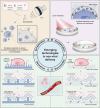Revolutionising Cancer Immunotherapy: Advancements and Prospects in Non-Viral CAR-NK Cell Engineering
- PMID: 39731215
- PMCID: PMC11969250
- DOI: 10.1111/cpr.13791
Revolutionising Cancer Immunotherapy: Advancements and Prospects in Non-Viral CAR-NK Cell Engineering
Abstract
The recent advancements in cancer immunotherapy have spotlighted the potential of natural killer (NK) cells, particularly chimeric antigen receptor (CAR)-transduced NK cells. These cells, pivotal in innate immunity, offer a rapid and potent response against cancer cells and pathogens without the need for prior sensitization or recognition of peptide antigens. Although NK cell genetic modification is evolving, the viral transduction method continues to be inefficient and fraught with risks, often resulting in cytotoxic outcomes and the possibility of insertional mutagenesis. Consequently, there has been a surge in the development of non-viral transfection technologies to overcome these challenges in NK cell engineering. Non-viral approaches for CAR-NK cell generation are becoming increasingly essential. Cutting-edge techniques such as trogocytosis, electroporation, lipid nanoparticle (LNP) delivery, clustered regularly interspaced short palindromic repeats-associated protein 9 (CRISPR-Cas9) gene editing and transposons not only enhance the efficiency and safety of CAR-NK cell engineering but also open new avenues for novel therapeutic possibilities. Additionally, the infusion of technologies already successful in CAR T-cell therapy into the CAR-NK paradigm holds immense potential for further advancements. In this review, we present an overview of the potential of NK cells in cancer immunotherapies, as well as non-viral transfection technologies for engineering NK cells.
Keywords: chimeric antigen receptor; immunotherapy; natural killer cell; non‐viral transfection; tumour microenvironment.
© 2024 The Author(s). Cell Proliferation published by Beijing Institute for Stem Cell and Regenerative Medicine and John Wiley & Sons Ltd.
Conflict of interest statement
The authors declare no conflicts of interest.
Figures




Similar articles
-
Non-viral approaches in CAR-NK cell engineering: connecting natural killer cell biology and gene delivery.J Nanobiotechnology. 2024 Sep 10;22(1):552. doi: 10.1186/s12951-024-02746-4. J Nanobiotechnology. 2024. PMID: 39256765 Free PMC article. Review.
-
Enhancement of anti-sarcoma immunity by NK cells engineered with mRNA for expression of a EphA2-targeted CAR.Clin Transl Med. 2025 Jan;15(1):e70140. doi: 10.1002/ctm2.70140. Clin Transl Med. 2025. PMID: 39763064 Free PMC article.
-
Use of Cell and Genome Modification Technologies to Generate Improved "Off-the-Shelf" CAR T and CAR NK Cells.Front Immunol. 2020 Aug 7;11:1965. doi: 10.3389/fimmu.2020.01965. eCollection 2020. Front Immunol. 2020. PMID: 32903482 Free PMC article. Review.
-
Genetic reprogramming for NK cell cancer immunotherapy with CRISPR/Cas9.Immunology. 2019 Oct;158(2):63-69. doi: 10.1111/imm.13094. Epub 2019 Aug 14. Immunology. 2019. PMID: 31315144 Free PMC article. Review.
-
Novel strategies to overcome tumor immunotherapy resistance using CAR NK cells.Front Immunol. 2025 May 29;16:1550652. doi: 10.3389/fimmu.2025.1550652. eCollection 2025. Front Immunol. 2025. PMID: 40510336 Free PMC article. Review.
Cited by
-
Current landscape of innovative drug development and regulatory support in China.Signal Transduct Target Ther. 2025 Jul 22;10(1):220. doi: 10.1038/s41392-025-02267-y. Signal Transduct Target Ther. 2025. PMID: 40691459 Free PMC article. Review.
-
Clinical evidence of immunogenicity of CAR-T cell therapies and its implication in the clinical development of CAR-T drug products.Front Immunol. 2025 Feb 21;16:1512494. doi: 10.3389/fimmu.2025.1512494. eCollection 2025. Front Immunol. 2025. PMID: 40061940 Free PMC article. Review.
-
Revolutionizing Autoimmune Kidney Disease Treatment with Chimeric Antigen Receptor-T Cell Therapy.Research (Wash D C). 2025 May 22;8:0712. doi: 10.34133/research.0712. eCollection 2025. Research (Wash D C). 2025. PMID: 40405911 Free PMC article. Review.
-
CAR-T cell therapy clinical trials: global progress, challenges, and future directions from ClinicalTrials.gov insights.Front Immunol. 2025 May 20;16:1583116. doi: 10.3389/fimmu.2025.1583116. eCollection 2025. Front Immunol. 2025. PMID: 40463393 Free PMC article. Review.
-
From Multi-Omics to Visualization and Beyond: Bridging Micro and Macro Insights in CAR-T Cell Therapy.Adv Sci (Weinh). 2025 May;12(20):e2501095. doi: 10.1002/advs.202501095. Epub 2025 May 11. Adv Sci (Weinh). 2025. PMID: 40349154 Free PMC article. Review.
References
Publication types
MeSH terms
Substances
Grants and funding
LinkOut - more resources
Full Text Sources
Medical

